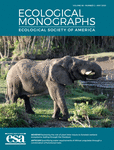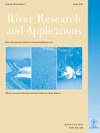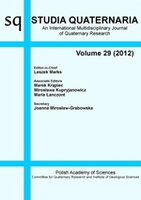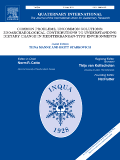
JOURNAL OF PALEOLIMNOLOGY
Scope & Guideline
Advancing Knowledge of Climate and Biodiversity Through Time
Introduction
Aims and Scopes
- Paleolimnological Record Analysis:
The journal emphasizes the reconstruction of historical lake environments through sediment core analysis, focusing on diatom, cladoceran, and other biological indicators to interpret ecological changes over time. - Climate and Environmental Change Studies:
Research often investigates the influences of climate change on lake ecosystems, including temperature fluctuations, hydrological changes, and sedimentary dynamics that provide insights into past climatic conditions. - Anthropogenic Impact Assessment:
There is a significant focus on the effects of human activities on lake ecosystems, including pollution, land-use changes, and resource exploitation, which are analyzed through sediment records and ecological responses. - Multi-proxy and Interdisciplinary Approaches:
The journal encourages the use of multi-proxy methodologies, integrating geochemical, biological, and sedimentological data to provide comprehensive insights into past environmental conditions. - Ecosystem Dynamics and Biodiversity:
Research on the dynamics of aquatic ecosystems, including biodiversity assessments and the response of various taxa to environmental changes, is a core aspect of the publications.
Trending and Emerging
- Human-Induced Climate Change Impacts:
There is a growing trend of studies focusing on the effects of anthropogenic climate change on lake ecosystems, emphasizing how human activities have altered natural processes and biodiversity. - Technological Innovations in Sediment Analysis:
Emerging methodologies, including metagenomics and advanced geochemical analyses, are increasingly being utilized to enhance understanding of sedimentary records and their ecological implications. - Interdisciplinary Research Linking Paleolimnology with Other Fields:
A notable increase in interdisciplinary studies, combining paleolimnology with archaeology, geology, and environmental science, reflects a broader approach to understand lake histories and their significance. - Focus on Restoration and Management Strategies:
Emerging research emphasizes the application of paleolimnological findings to inform lake restoration and management practices, addressing contemporary ecological challenges. - Inclusion of Social and Ethical Dimensions:
There is a rising interest in exploring diversity, equity, and inclusion within paleolimnological research, as well as understanding the socio-ecological implications of past and present lake management.
Declining or Waning
- Focus on Traditional Paleoecological Studies:
There appears to be a waning interest in purely traditional paleoecological approaches that do not incorporate modern technological advancements or interdisciplinary methodologies, with fewer studies relying solely on basic sediment analysis. - Limited Exploration of Tropical Lake Dynamics:
Research focused on tropical lake ecosystems has decreased in frequency, suggesting a shift towards temperate and high-latitude studies, possibly due to funding and research interest trends. - Decreased Emphasis on Historical Baselines:
There is a noticeable reduction in studies aiming to establish historical baselines for lake conditions, as researchers may prioritize contemporary issues and immediate environmental impacts over historical reconstructions. - Less Attention to Specific Taxa Studies:
The journal has seen fewer publications dedicated to in-depth studies of specific taxa, such as certain diatom or cladoceran species, in favor of broader ecological or environmental assessments.
Similar Journals

Science of The Total Environment
Leading the Way in Environmental Research ExcellenceScience of The Total Environment, an esteemed journal published by Elsevier, holds a significant position in the field of environmental science, encompassing critical areas such as Environmental Chemistry, Environmental Engineering, Pollution, and Waste Management and Disposal. With an impressive impact factor and ranked in the Q1 quartile across its categories for 2023, the journal is recognized for its high-quality research output and contribution to environmental sustainability. Operating from its base in the Netherlands, the journal has been a valuable resource since its inception in 1972, welcoming innovative studies that address complex environmental challenges. Its notable rankings—such as Rank #9 in both Environmental Sciences and Pollution—underscore its relevance and influence in the academic community. Although the journal currently does not provide an open access option, the robust findings and discussions presented within its pages continue to foster a deeper understanding of environmental issues. Science of The Total Environment is an essential platform for researchers, professionals, and students dedicated to advancing knowledge and solutions in the rapidly evolving field of environmental science.

LAKE AND RESERVOIR MANAGEMENT
Advancing sustainable solutions for aquatic ecosystems.LAKE AND RESERVOIR MANAGEMENT is a premier academic journal published by Taylor & Francis Inc, providing a dedicated platform for the dissemination of high-quality research and innovations in the field of aquatic management. With an ISSN of 1040-2381 and an E-ISSN of 2151-5530, the journal encompasses a broad spectrum of topics related to the sustainable management and ecological assessment of lakes and reservoirs. As an essential resource for researchers, professionals, and students involved in environmental science, hydrology, and water resource management, the journal aims to address critical issues such as water quality, ecosystem services, and the impact of human activities on aquatic systems. Additionally, the journal promotes interdisciplinary approaches that foster collaborative solutions for effective management of aquatic resources. Although it currently does not offer open access, LAKE AND RESERVOIR MANAGEMENT remains influential in shaping policies and practices within the field, making it a vital read for anyone dedicated to advancing knowledge and practice in aquatic ecosystem management.

Bulletin of Geography-Physical Geography Series
Illuminating the complexities of our physical world.The Bulletin of Geography-Physical Geography Series is a prominent open-access journal dedicated to advancing the field of physical geography. Published by Nicolaus Copernicus University in Poland, this journal has been a vital resource for researchers, professionals, and students alike since its inception in 2009. With an ISSN of 2080-7686 and an E-ISSN of 2300-8490, it contributes significantly to the academic discourse in geography, planning and development, and geophysics, boasting a 2023 Scopus rank of #385 in Social Sciences and #84 in Earth and Planetary Sciences. The journal aims to disseminate innovative research and critical insights that address contemporary challenges in physical geography, making it a valuable platform for those seeking to contribute to or stay informed about the latest developments in the field. With its commitment to quality and accessibility, the Bulletin of Geography-Physical Geography Series plays a crucial role in fostering scholarly exchange and collaboration globally.

ECOLOGICAL MONOGRAPHS
Bridging theory and practice in the realm of ecological science.ECOLOGICAL MONOGRAPHS, published by WILEY, stands as a premier journal in the field of ecology, evolution, behavior, and systematics, with an impressive impact factor and ranking in the 96th percentile among its peers. Since its inception in 1974, this journal has offered comprehensive insights and advanced knowledge on ecological phenomena, serving as a vital resource for researchers, professionals, and students alike. With its commitment to publishing high-quality, peer-reviewed articles, it operates within the esteemed Q1 category of ecology, solidifying its reputation as a leading platform for innovative research. Though not available as open access, ECOLOGICAL MONOGRAPHS ensures broad reach and visibility through its rigorous editorial standards and substantial scholarly contributions. As it continues to aggregate vital ecological data and synthesize research across multiple converged years, this journal remains invaluable for those dedicated to understanding complex ecological interactions and their implications for environmental policy and management.

RIVER RESEARCH AND APPLICATIONS
Innovating Research for Dynamic Water ResourcesRIVER RESEARCH AND APPLICATIONS, published by WILEY, stands as a pivotal journal in the fields of Environmental Science, Water Science and Technology, and Environmental Chemistry. With an impressive Impact Factor signifying its influential presence, this journal offers a platform for high-quality research and applications related to river ecosystems and water resources. The journal operates under a hybrid access model, allowing for both subscription-based and open-access options, thus promoting accessibility and widespread dissemination of knowledge. Since its inception in 1996, RIVER RESEARCH AND APPLICATIONS has maintained a distinguished reputation, reflected in its ranking within the Q2 quartiles of major categories like Environmental Chemistry and Water Science. Engaging researchers, practitioners, and students alike, the journal is committed to publishing cutting-edge studies that foster a deeper understanding of river dynamics and their environmental implications, making it an essential resource for contributors advancing the sustainable management of water environments.

HOLOCENE
Charting the Course of Human-Environment Dynamics.HOLOCENE is a leading academic journal published by SAGE Publications Ltd that serves as an essential platform for researchers and scholars in the fields of archaeology, earth-surface processes, ecology, and paleontology. With an impressive Q1 ranking in prominent categories like Archaeology, Earth-Surface Processes, and Paleontology, this journal is dedicated to disseminating high-quality research that examines the dynamic interactions between humans and their environment throughout the Holocene epoch. Released biannually, it covers innovative studies and comprehensive review articles that contribute to our understanding of environmental changes and their implications across various disciplines. Although it does not offer open access, HOLOCENE maintains a robust reputation with an influential impact on the academic community, making it a vital resource for professionals, researchers, and students who aim to expand their knowledge and explore current developments in Earth and environmental sciences. With a commitment to excellence, HOLOCENE continues to shape the discourse in its field from its headquarters in the United Kingdom.

Studia Quaternaria
Uncovering the secrets of geology and Earth-surface interactions.Studia Quaternaria is a leading academic journal published by the Polish Academy of Sciences, Institute of Geological Sciences, specializing in the dynamic fields of Earth-Surface Processes and Geology. With an ISSN of 1641-5558 and an E-ISSN of 2300-0384, this journal has been a prominent platform for scholarly discourse since its inception in 2000. Operating under the open-access model, it aims to disseminate high-quality research that is accessible to a global audience. Studia Quaternaria holds a Q3 ranking in both relevant quartiles as of 2023, indicating its commitment to advancing knowledge in its disciplines despite centering in competitive academic environments. With its publications indexed in Scopus, the journal remains a valuable resource for researchers, professionals, and students looking to stay abreast of innovations and discoveries in Earth-Surface Processes and Geology. Encompassing a broad scope of studies, the journal represents an essential contribution to the geological sciences, fostering a deeper understanding of our planet's changes and processes.

Depositional Record
Connecting past and present through innovative depositional studies.Depositional Record, published by WILEY, stands as a vital resource for researchers and professionals in the fields of Geology, Paleontology, Oceanography, and Environmental Science. Since its inception in 2015, this Open Access journal has been dedicated to advancing the understanding of sedimentary processes, depositional environments, and their implications on Earth's history and contemporary climate dynamics. With an impressive array of categorizations, including Q1 rankings in Geology, Paleontology, and Stratigraphy, it underscores its significant contribution to these scientific arenas. The journal’s reach is reflected in its Scopus rankings, placing it within the top quartiles in multiple categories, indicating the high quality and impact of its published research. Researchers, students, and professionals who engage with Depositional Record will find a treasure trove of knowledge aimed at informing best practices, innovative studies, and fostering an interdisciplinary dialogue crucial for environmental stewardship and geological exploration.

QUATERNARY INTERNATIONAL
Advancing Knowledge of the Quaternary Period.Quaternary International is a prestigious journal published by Pergamon-Elsevier Science Ltd, focusing on the interdisciplinary study of the Quaternary Period, which encompasses significant geological, hydrological, and climatic changes. With an ISSN of 1040-6182 and E-ISSN 1873-4553, it stands as a critical resource in the realm of Earth-Surface Processes, achieving a strong position within the academic community, evidenced by its 2023 Scopus rank of #32 out of 179 in this category, corresponding to an impressive 82nd percentile. Since its inception in 1989, this journal has provided valuable insights and contributed to the advancement of knowledge in the Earth and Planetary Sciences. Researchers, professionals, and students alike will find a wealth of original research articles, reviews, and case studies that inform and inspire further studies in the Quaternary sciences. Although the journal does not currently offer open access options, its reputation for rigorous peer review and impactful content underscores its significance in shaping scholarly discourse in the field.

Earth Interactions
Illuminating Earth’s Interactions for Tomorrow’s ScholarsEarth Interactions is a prominent journal that serves as a critical platform for interdisciplinary research in the field of Earth and Planetary Sciences. Published by the American Meteorological Society, this journal has established itself as a key resource for scholars, researchers, and professionals dedicated to understanding Earth's complex systems and their interactions. With an impressive Q1 ranking in the category of Earth and Planetary Sciences for 2023, it reflects a commitment to high-quality scholarship and impactful contributions to the field. The journal, with its dedicated coverage from 2004 to 2024, encompasses a wide array of topics, providing comprehensive insights into geological, atmospheric, and environmental phenomena. Although it operates under a non-open access model, its significance is underscored by its placement in the top percentile of Scopus rankings (Rank #89/195), making it an exciting resource for those pursuing advanced studies and applications related to Earth's systems.